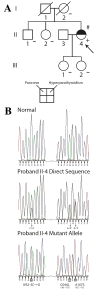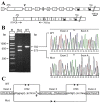Novel association of MEN1 gene mutations with parathyroid carcinoma
- PMID: 28693130
- PMCID: PMC5494910
- DOI: 10.3892/ol.2017.6162
Novel association of MEN1 gene mutations with parathyroid carcinoma
Abstract
Inactivating mutations of the multiple endocrine neoplasia 1 (MEN1) gene cause MEN1 syndrome, characterized by primary hyperparathyroidism (pHPT), and parathyroid and gastro-entero-pancreatic pituitary tumors. At present, only 14 cases of malignant parathyroid tumor have been associated with the syndrome, with 6 cases carrying an inactivating mutation of the MEN1 gene. The present study presents the case of a 48-year-old female who presented with multigland pHPT and multiple pancreatic lesions. The patient underwent surgery several times for the excision of parathyroid hyperplasia, carcinoma and adenoma. The MEN1 gene was screened, revealing three variants (in cis) at the intron/exon 3 boundary (IVS2-3G>C, c.497A>T and c.499G>T) detected on the DNA of the proband, not shared by her relatives. RNA sequencing revealed that the IVS2-3C>G variant caused the skipping of the exon 3. Therefore, the present study reports on a novel rare association of MEN1 syndrome and parathyroid carcinoma. The reported splicing mutation was previously identified in subjects who always developed malignant lesions; thus, a possible genotype-phenotype association may be considered.
Keywords: MEN1; multiple endocrine neoplasia; parathyroid carcinoma.
Figures




References
-
- Heppner C, Bilimoria KY, Agarwal SK, Kester M, Whitty LJ, Guru SC, Chandrasekharappa SC, Collins FS, Spiegel AM, Marx SJ, Burns AL. The tumor suppressor protein menin interacts with NF-kappaB proteins and inhibits NF-kappaB-mediated transactivation. Oncogene. 2001;20:4917–4925. doi: 10.1038/sj.onc.1204529. - DOI - PubMed
LinkOut - more resources
Full Text Sources
Other Literature Sources
